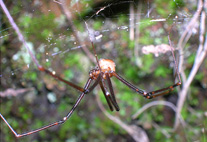Abstract
A new species of Pseudopaludicola is described from the Cerrado of southeastern Brazil. Pseudopaludicola facureae sp. nov. is diagnosed from the P. pusilla species group by the absence of either T-shaped terminal phalanges or toe tips expanded, and distinguished from almost all recognized taxa currently assigned to Pseudopaludicola (except P. canga, P. giarettai, and P. hyleaustralis) by possessing a non-pulsed advertisement call. However, the advertisement call of the new species consists of the emission of well-defined call series, whereas the advertisement call of P. giarettai is long (117–187 ms) and with an isolated emission pattern; respecting to P. canga, the new species emits very long notes series (up to 53 notes/advertisement call), compared to the short call series of P. canga (up to 9 notes/advertisement call); considering P. hyleaustralis, the new species has a shorter note duration (15–35 ms), higher note rate per minute (480–1860), and higher dominant frequency (4076–5108).
References
Britski, H.A. & Garavello, J.C. (2003) Hisonotus insperatus: new species, from the upper rio Paraná basin (Pisces: Ostariophysi: Loricariidae). Copeia, 3, 588–593. http://dx.doi.org/10.1643/CI-02-23R
Calegari, B.B. & Reis, R.E. (2010) A new species of Microlepidogaster (Siluriformes: Loricariidae: Hypoptopomatinae) from the upper rio Paraná basin, Brazil. Neotropical Ichthyology, 8(3), 625–630.
Eigenmann, C.H. & Eigenmann, R.S. (1889) Preliminary notes on South American Nematognathi, II. Proceedings of the California Academy of Sciences, 2, 28–56.
Ferreira, K.M. & Ribeiro, A.C. (2007) Corumbataia britskii (Siluriformes: Loricariidae: Hypoptopomatinae) a new species from the upper Rio Paraná basin, Mato Grosso do Sul, Central Brazil. Zootaxa 1386, 59–68.
Lima, F.C.T. & Ribeiro, A.C. (2011) Continental-Scale Tectonic Controls of Biogeography and Ecology. In: Albert, J. S. & Reis, R. E. (Eds), Historical Biogeography of Neotropical Freshwater Fishes. University of California Press, Berkeley, pp. 145–164. http://dx.doi.org/10.1525/california/9780520268685.003.0009
Martins, F.O. (2012) Análise Filogenética e Revisão Taxonômica de Pseudotothyris Britski & Garavello, 1984 (Loricariidae: Hypoptopomatinae). M. Sc. Thesis. Universidade Estadual Paulista Júlio de Mesquita Filho, São José do Rio Preto, 188 pp.
Martins, F.O. & Langeani, F. (2011a) Rhinolekos, a new genus with three new species of Hypoptopomatinae (Siluriformes: Loricariidae) from upper rio Paraná. Neotropical Ichthyology, 9(1), 65–78. http://dx.doi.org/10.1590/S1679-62252011000100004
Martins, F. O. & Langeani, F. (2011b) Microlepidogaster dimorpha, a new species of Hypoptopomatinae (Siluriformes: Loricariidae) from the upper rio Paraná system. Neotropical Ichthyology, 9(1), 79–86. http://dx.doi.org/10.1590/S1679-62252011000100005
Martins, F.O. & Langeani, F. (2012) Hisonotus piracanjuba, a new species of Hypoptopomatinae (Siluriformes: Loricariidae) from the rio Paranaíba, upper rio Paraná system, central Brazil. Ichthyological Exploration of Freshwaters, 23(1), 29–36.
Menezes, N.A., Ribeiro, A.C., Weitzman, S. & Torres, R.A. (2008) Biogeography of Glandulocaudinae (Teleostei: Characiformes: Characidae) revisited: phylogenetic patterns, historical geology and genetic connectivity. Zootaxa, 1726, 33–48.
Pavanelli, C.S. & Britski, H.A. (1999) Description of a new species of Steindachnerina (Teleostei: Characiformes: Curimatidae) from the upper Rio Paraná basin, Brazil. Ichthyological Exploration of Freshwaters, 10(3), 211–216.
Reis, R.E. & Schaefer, S.A. (1998) New Cascudinhos from Southern Brazil: Systematics, Endemism, and Relationships (Siluriformes, Loricariidae, Hypoptopomatinae). American Museum Novitates, 3254, 1–25.
Ribeiro, A.C. (2006) Tectonic history and the biogeography of the freshwater fishes from the coastal drainages of eastern Brazil: an example of faunal evolution associated with a divergent continental margin. Neotropical Ichthyology, 4(2), 225–246. http://dx.doi.org/10.1590/S1679-62252006000200009
Ribeiro, A.C., Benine, R.C. & Figueiredo, C.A. (2004) A new species of Creagrutus Günther (Teleostei: Ostariophysi: Characiformes), from the upper Rio Paraná basin, central Brazil. Journal of Fish Biology, 64, 597–611. http://dx.doi.org/10.1111/j.1095-8649.2004.00324.x
Ribeiro, A.C., Carvalho M. & Melo, A.L.A. (2005) Description and relationship of Otothyropsis marapoama, a new genus and species of Hypoptopomatinae catfish (Siluriformes: Loricariidae) from rio Tietê basin, southeastern Brazil. Neotropical Ichthyology, 3(4), 489–498. http://dx.doi.org/10.1590/S1679-62252005000400006
Schaefer, S.A. (1997) The Neotropical cascudinhos: Systematics and biogeography of the Otocinclus catfishes (Siluriformes: Loricariidae). Proceedings of the Academy of Natural Sciences of Philadelphia, 148, 1–120.
Schaefer, S.A. (1998) Conflict and Resolution: Impact of New Taxa on Phylogenetic Studies of the Neotropical Cascudinhos (Siluroidei: Loricariidae). In: Malabarba, L. R., Reis, R. E., Vari, R. P., Lucena, Z. M. S. & Lucena, C. A. S. (Eds), Phylogeny and Classification of Neotropical Fishes. Edipucrs, Porto Alegre, pp. 375–400.
Taylor, W.R. & Van Dike, G.C. (1985) Revised procedures for staining and clearing small fishes and other vertebrates for bone and cartilage study. Cybium, 9(2), 107–119.

